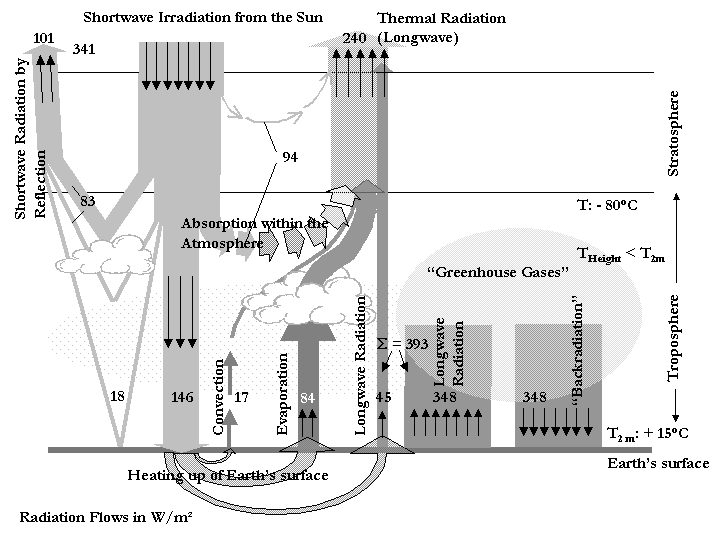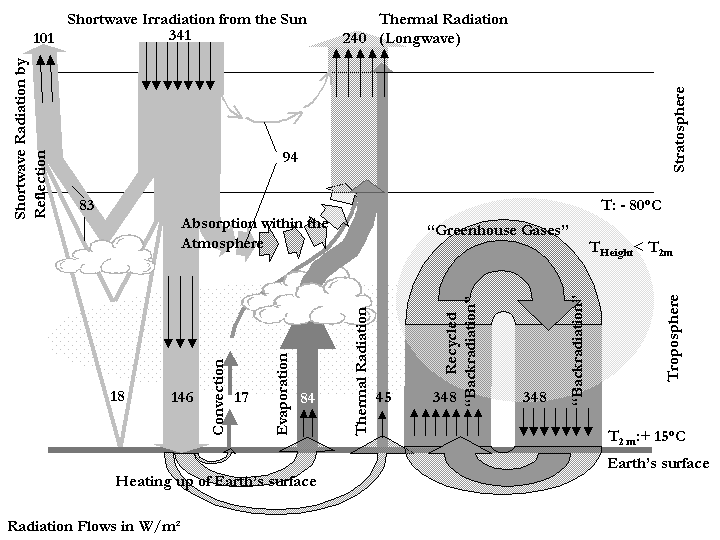
Contribution to the discussion about Anthropogenic Climate Change:
On the Phenomenon of Atmospheric Backradiation
© Heinz Thieme
Deutsche Version siehe: http://real-planet.eu/gegenstrahlung.htm
The phenomenon of “atmospheric backradiation” is presently advanced as an explanation of thermal conditions on Earth, and as the basis of some statements about climate change. However, scientific evaluation in strict accord with the laws of physics and mathematics suggests that “atmospheric backradiation” is physical nonsense.
The “greenhouse effect” and its ramifications form the substantive basis for assertions by climatologists, and occasionally meteorologists, about anthropogenic climate change. Those who use the term – for example Kraus [1] – understand it to signify “...that near-surface air temperature is much higher than (radiative) balance with outgoing terrestrial radiation would imply. Thus, annual average global temperature 2 metres from the earth’s surface is 15 degrees Celsius, whereas the calculated radiative temperature is minus 18 degrees.” This is supposedly because “Surface temperature [N.B.: no longer the temperature at 2 metres: Thuene has remarked on this conflation of two quantities that have only a limited and fluctuating connexion] results from longwave radiation (= infra-red radiation) from atmospheric emitters (e.g. CO2 and H2O in gaseous state, as well as clouds and aeorosol particles), as well as from the fact that solar radiation is absorbed by the earth and not the atmosphere.”
I have thoroughly discussed elsewhere [3,4,5] the material errors in the quoted statement. The following remarks deal only with a single concept vital to the greenhouse thesis: so-called “atmospheric backradiation”.
The idea of “atmospheric backradiation” has long haunted the scientific literature on the principal boundary conditions for terrestrial temperature. Milankovitch already referred to a “dark atmospheric radiation” whose main energy source was the absorption of incoming solar radiation: “In an overcast sky, rays reaching the clouds will be partly reflected, partly allowed to pass through, and partly absorbed, in which case they become the source of dark atmospheric radiation emanating from the clouds themselves”[6]. “Dark radiation” later mutated into “atmospheric backradiation”. Ufer offers a detailed account [7], and points to alternative explanations of terrestrial temperature conditions and variability.
The following diagram is adapted from a presentation on the Max Planck Institute for Meteorology website [8]; similar pictures are displayed in textbooks [9, 10]:

Fig. 1: Radiative and other energy fluxes in the atmosphere
3. Assessment of “atmospheric backradiation”
Fig. 1 reminds us that the temperature in the troposphere decreases with increasing height, and may also call to mind the Second Law of Thermodynamics (in Clausius’ formulation): “Warmth can never pass from a colder to a warmer body unless another related change occurs at the same time” (cf. Baehr, [11]), or more simply “Warmth can never spontaneously pass from a body of low temperature to a body of higher temperature” (see Schmidt, [12]). The Law may raise doubts about how “atmospheric backradiation” can work. In fact, properly considered, it already suggests that “atmospheric backradiation” is a mirage.
Even disregarding the Second Law, close inspection of the mathematical boundary conditions of the radiative fluxes represented in Figure 1 also suggests that “atmospheric backradiation” is nonsense. Both terrestrial radiation and claimed “atmospheric backradiation” are radiant fluxes. As such, they are definable as to direction and magnitude; i.e. as vectors. Now the combination (in this case, addition) of vectors produces a new vector (see Bronstein-Semendjajew [13]), with the proviso that two exactly equal vectors of contrary direction sum to zero.
In the light of the laws of vector analysis, it is useful to split the flux of terrestrial long-wave radiation shown in Fig. 1 (393 W/m²) into its components, namely heat dissipation by radiation into space (45 W/m²), and re-radiation of “atmospheric backradiation" (348 W/m²). Now it is clear that only the 45 W/m² is thermal radiation of the earth's surface, see Fig. 2. The remaining 348 W/m² and the “atmospheric backradiation”, which is equal in size but opposite in direction, sum to zero. So this breakdown into outgoing radiation from the surface and “atmospheric backradiation” is sheer physical nonsense.

Fig. 2: Radiative and other energy fluxes in the atmosphere (Circulation of “atmospheric backradiation” and consequent additional longwave terrestrial radiation added by HT)
“Atmospheric backradiation” is an arbitrary construct evoked to explain the temperature observed at the Earth's surface. But calculations employing the concept of “atmospheric backradiation” flout the only admissible view of thermodynamic equilibrium. Moreover, the calculations conflate air temperature (measured with Stevenson screens 2 meters above the ground) and the temperature of the face of the earth itself (not really reliably measurable: sharp fluctuations mean that only an instantaneous radiation-temperature can be recorded), the result being expressed as surface temperature. The method is illustrated by Malberg [14] and Kraus [1].
The picture of the radiant fluxes presented in Fig. 2 makes it clear that any value is possible for the component of longwave terrestrial radiation that might return as “atmospheric backradiation”. Provided the final effective thermal radiation flowing from Earth toward space amounts to 45 W/m², the share of the remaining 348 W/m² flux of radiation that participates in the radiation-"atmospheric backradiation" cycle could assume any value from zero to infinity. Only one condition must be satisfied: that the total of the components of longwave radiation caused by recycled “atmospheric backradiation” and “atmospheric backradiation” itself must be zero.
Thus, applying the model of “atmospheric backradiation” and recycled “atmospheric backradition” would allow the calculation of any temperature of the earth's surface. The possibility of arriving at any and every possible result proves that the postulated “atmospheric backradiation” is an unreliable and inadmissible concept. “atmospheric backradiation” can only be considered as a mistake and a mirage evoked by people who tried to explain the thermal conditions on Earth without having the necessary background in physics to understand the effects of atmospheres. It is a further example of the process described at [15] of “From mistake to theorem”.
It should be noted however that NASA
does not show any more "backradiation" nowadays in its
relevant representation of the energy budget of the earth: http://eosweb.larc.nasa.gov/EDDOCS/images/Erb/components2.gif
.
4. Summary
An assessment conducted in the light of the Second Law of Thermodynamics and the principles of vector algebra of the key greenhouse theory concept of “atmospheric backradiation” suggests that it is simply a mirage. The only “Backradiation Phenomenon” that needs explaining is how this physical nonsense maintains its place in numerous earth sciences textbooks at both school and university level.
A question to the reader (similar on http://real-planet.eu/wspeicher.htm)
Finally a question, dear reader, why is the surface temperature of the moon during almost perpendicular sun exposure remarkably higher than the ground surface temperature in comparable areas on our Earth, e.g. in the Sahara with likewise comparable conditions concerning the sun exposure? In different sources for the moon surface temperature values of around 130°C are given (the surface temperature at the equator during the day is 134°C (273° F) source: http://lunar.gsfc.nasa.gov/moonfacts.html). Ground surface temperature in comparable areas on the Earth, e.g. in the Sahara, with likewise comparable conditions concerning the sun exposure show lower values. Own measurements during almost perpendicular position of the sun, clear sky, in the northern Sahara led to ground surface temperatures of around 80°C. Other sources give temperatures only around 60°C. Own measurements of ground surface temperature in northern part of Mediterranean Sea area have shown already results of 65°C. And this, compared to the moon surface, poor result for the Earth ground surface temperature, is achieved under the main stream idea that the earth has a heating greenhouse effect. The moon because of lack of an atmosphere is however without such an effect. The reason for the higher temperatures on the moon cannot be that the moon day is longer than Earth day. In the sun at noon the (ground)surface temperature does not rise in Sahara further, if it achieved the highest value, which is reached already some minutes before noon (local time). After further 30 minutes of sun irradiation the value already measured does not continue to rise.
5. List of Sources
[1] Kraus, H., Die Atmosphäre der Erde, Friedr. Vieweg & Sohn Verlagsgesellschaft mbH, Braunschweig/Wiesbaden, 2000, p.128.
[2] Thuene, W., Die Temperaturstrahlung, die Infrarot-Thermographie und der sogenannte „Treibhauseffekt“, KI Luft- und Kältetechnik, 4/1999, p. 211
[3] Thieme, H., Treibhauseffekt ohne wissenschaftliche Grundlage, Elektrizitätswirtschaft, Jg. 98 (1999), Heft 20, S 8 ff., (near-identical text: http://krahmer.freepage.de/klima/thieme/thieme.html )
[4] Thieme, H., Greenhouse Gas Hypothesis Violates Fundamentals of Physics, http://realplanet.eu/error.htm
[5] Thieme, H., The Thermodynamic Atmosphere Effect, http://realplanet.eu/atmoseffect.htm
[6] Milankovitch, M., Mathematische Klimalehre, Berlin,1930, Kraus Reprint, Nendeln/Liechtenstein, 1972, p. A55
[7] Ufer, D., Energiewirtschaft und Klimakatastrophe, Energie, Umwelt und Wirtschaft: Visionen statt Illusionen, B. G. Teubner, Stuttgart Leipzig, 1999, p. 28
[8] http://mpimet.mpg.de/Depts/Modell/EXPO/hintergrund.html
[9] Lutgens, K. /Tarbuck, E.J, The Atmosphere, Prentice Hall, 1979, p. 37
[10] Salby, M. L., Fundamentals of Atmospheric Physics, Academic Press, Inc., 1996, p.45
[11] Baehr, H. D., Thermodynamik, Springer-Verlag, Berlin Heidelberg New York, 1973, p. 33
[12] Schmidt, E., Einführung in die Technische Thermodynamik, Springer-Verlag, Berlin/Göttingen/Heidelberg, 1953, p.68
[13] Bronstein, I. N., Semendjajew, K. A., Taschenbuch der Mathematik, 6. Aufl., B.G. Teubner Verlagsgesellschaft, Leipzig, 1961, p. 447
[14] Malberg, H., Meteorologie und Klimatologie, 3. Aufl., Springer, 1997, p. 47
[15] Beck-Bornholdt, H.-P., Dubben, H.-H., Der Hund, der Eier legt, Rowohlt Taschenbuch Verlag GmbH, Reinbek bei Hamburg, 1997
Page originally posted 18.08.2001; by S. Scott revised translation July 2003; links updated: 09.02.2007, some refurbishments 15.06.2011
The author is co-author and belongs to the initial signers of the Climate Declaration of Heiligenroth http://klimamanifest-von-heiligenroth.de/klimaman-e.html#
Worth to be read: "The Skeptics Handbook" http://joannenova.com.au/globalwarming/the_skeptics_handbook_2-22_lq.pdf .